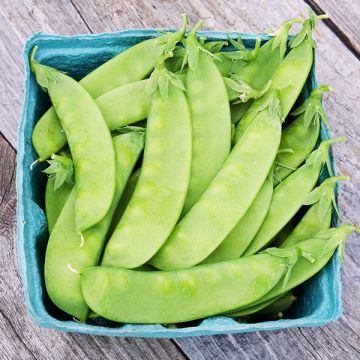
Pisum sativum
Avalanche Snow Pea
Days to Maturity: 62 days
SKU
2739
Out of stock
Get notified when this product is back in stock
notify meManageable and productive plants producing large, dark green pods.
Pods can be harvested baby or at full size and are tender and sweet. Compact 35-40" plants boast avalanches of ripe pods that are perfect for fresh market or freezing. Plants are Afila-type, meaning less leaves and more tendrils. Tendrils are abundant and strong, allowing plants to hold each other up in the field, requiring less trellising. From our partners at Pure Line Seeds.
- Afila-type
- 4-5"
- Open-Pollinated
Disease Resistance Details
Intermediate Resistance: Fusarium Wilt (1), Powdery Mildew
Cultural Info
Peas (Pisum sativum) are a cool season annual in the Leguminosae family, which includes beans, garbanzos, lentils, and peanuts.
- Shell peas, or English peas, are tender peas growing inside a tough pod which is discarded.
- Snow peas have a sweet a delectable pod. These are harvested while peas are still small.
- Snap peas have a succulent edible pod as well as plump sweet peas.
Soil Nutrients and Requirements
Because peas are planted in the early spring when conditions are often wet, good drainage is important. Sandy soils are best. Ensure good yields by adjusting soil pH to above 6.0 using lime, or wood ash where soils are low in potassium. For nitrogen, 20-30 lbs /acre is adequate. Higher amounts may cause lush foliage with poor flowering and fruit set. Peas fix nitrogen in the soil through a symbiotic relationship with bacteria. To ensure adequate numbers of pre-existing bacteria, mix seed with inoculants right before planting.
Seeding Depth
Seeding depth: 1-2”
Plant Spacing
Thin if desired to 2”
Row Spacing
1-1.5"
When to Sow
Direct seed as soon as soil can be worked in the spring. Seeds will germinate in soil temperatures as low as 40°F, although slowly. When soils are around 60°F, seeds will germinate more quickly. Hot, dry conditions adversely affect quality and yield, so it is advantageous to have the crop mature as early as planting schedules allow. In some regions, you can grow a successful fall crop by planting in late summer.
Harvest
Harvest when pods fill out, but before seeds turn starchy. Regular picking will increase yields.
Storage
Keep pea pods at near freezing temperatures for around a week.
Pest Info
- Aphids can be washed off plants with a hard stream of water. They have several natural predators that control populations including parasites (aphids appear grey or bloated), lady beetle larvae and lacewings.
- Seedcorn maggot – Avoid heavy applications of manure or organic matter, as this can attract the flies and encourage egg laying.
Disease Info
- Peas are subject to an array of root rots and wilts caused by different pathogens that are difficult to distinguish in the field and extremely difficult to control. The pathogens survive in the soil in dormant states that can persist for many years. Varieties resistant to all races of Fusarium oxysporum f. sp. pisi are available, and others with resistance to Pythium spp. and Fusarium solani f. sp. pisi are under development.
- Peas are also subject to several leaf and pod blights, of which the most important are probably aschochyta blight (caused by any of three related species) and bacterial blight ( Pseudomonas syringae pv. pisi). Both these diseases are highly transmissible by seed; all of our pea seed is grown in arid areas in which these diseases do not occur. All pea plant residues should be buried, burned, or composted at high temperatures to destroy disease organisms.
- Powdery mildew can be checked by providing good air circulation. Give plants wide spacing and eliminate weeds, especially milkweed, marshcress and yellowrocket. Choose resistant varieties.







